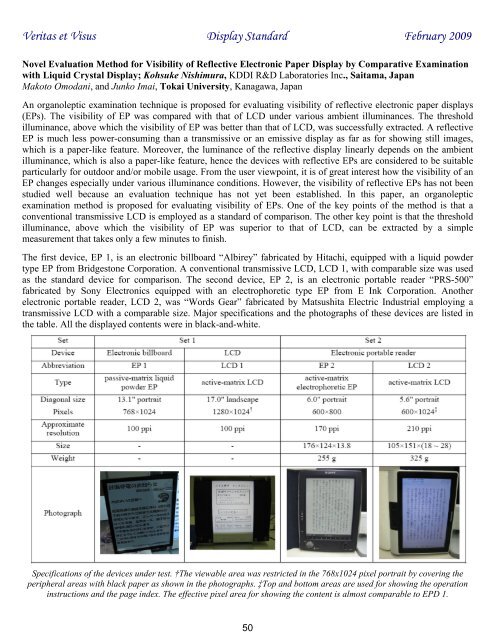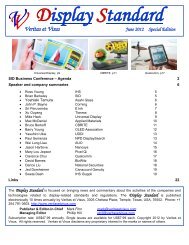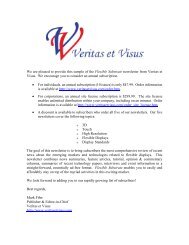Create successful ePaper yourself
Turn your PDF publications into a flip-book with our unique Google optimized e-Paper software.
<strong>Veritas</strong> <strong>et</strong> <strong>Visus</strong> <strong>Display</strong> <strong>Standard</strong> February 2009<br />
Novel Evaluation M<strong>et</strong>hod for Visibility of Reflective Electronic Paper <strong>Display</strong> by Comparative Examination<br />
with Liquid Crystal <strong>Display</strong>; Kohsuke Nishimura, KDDI R&D Laboratories Inc., Saitama, Japan<br />
Makoto Omodani, and Junko Imai, Tokai University, Kanagawa, Japan<br />
An organoleptic examination technique is proposed for evaluating visibility of reflective electronic paper displays<br />
(EPs). The visibility of EP was compared with that of LCD under various ambient illuminances. The threshold<br />
illuminance, above which the visibility of EP was b<strong>et</strong>ter than that of LCD, was successfully extracted. A reflective<br />
EP is much less power-consuming than a transmissive or an emissive display as far as for showing still images,<br />
which is a paper-like feature. Moreover, the luminance of the reflective display linearly depends on the ambient<br />
illuminance, which is also a paper-like feature, hence the devices with reflective EPs are considered to be suitable<br />
particularly for outdoor and/or mobile usage. From the user viewpoint, it is of great interest how the visibility of an<br />
EP changes especially under various illuminance conditions. However, the visibility of reflective EPs has not been<br />
studied well because an evaluation technique has not y<strong>et</strong> been established. In this paper, an organoleptic<br />
examination m<strong>et</strong>hod is proposed for evaluating visibility of EPs. One of the key points of the m<strong>et</strong>hod is that a<br />
conventional transmissive LCD is employed as a standard of comparison. The other key point is that the threshold<br />
illuminance, above which the visibility of EP was superior to that of LCD, can be extracted by a simple<br />
measurement that takes only a few minutes to finish.<br />
The first device, EP 1, is an electronic billboard “Albirey” fabricated by Hitachi, equipped with a liquid powder<br />
type EP from Bridgestone Corporation. A conventional transmissive LCD, LCD 1, with comparable size was used<br />
as the standard device for comparison. The second device, EP 2, is an electronic portable reader “PRS-500”<br />
fabricated by Sony Electronics equipped with an electrophor<strong>et</strong>ic type EP from E Ink Corporation. Another<br />
electronic portable reader, LCD 2, was “Words Gear” fabricated by Matsushita Electric Industrial employing a<br />
transmissive LCD with a comparable size. Major specifications and the photographs of these devices are listed in<br />
the table. All the displayed contents were in black-and-white.<br />
Specifications of the devices under test. †The viewable area was restricted in the 768x1024 pixel portrait by covering the<br />
peripheral areas with black paper as shown in the photographs. ‡Top and bottom areas are used for showing the operation<br />
instructions and the page index. The effective pixel area for showing the content is almost comparable to EPD 1.<br />
50






